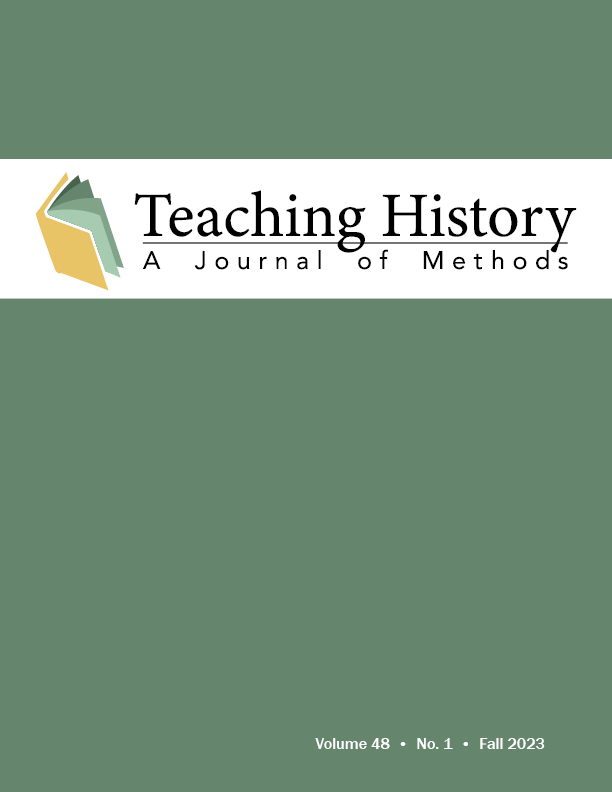Historical Practice and Authentic Assessment in an Introductory World History Course
DOI:
https://doi.org/10.33043/TH.48.1.3-25Keywords:
World History, Assessment, podcast, museum, artifactsAbstract
World History classrooms are ideal environments to introduce students to authentic assessment using museum websites. Student-created podcasts place students in the position of a curator, who must select a focal artifact, observe and analyze it, and contextualize its use and meaning with both primary and secondary sources. This article tracks the introduction of a scaffolded series of activities that aids students in conducting artifact-based analysis. These activities introduce students to close examination of museum artifacts, inference by comparing artifacts, and contextualization with scholarly secondary sources. As this article shows, the activities resulted in students using museum websites to select useful comparative artifacts, employing more secondary sources in their analysis and more scholarly sources. Using this series of activities will help instructors guide students toward successfully employing the historian’s best practices and assessing students in ways that are authentic to the discipline of History.
Downloads
References
Archbald, Doug A., and Newmann, Fred M. Beyond Standardized Testing: Assessing Authentic Academic Achievement in Secondary School. Reston, VA: National Association of Secondary School Principals, 1988.
Ashford-Rowe, Kevin, Herrington, Janice, and Christine Brown. “Establishing the critical elements that determine authentic assessment.” Assessment and Evaluation in Higher Education 39, no. 2 (2014): 205-222. https://doi.org/10.1080/02602938.2013.819566.
Barker, Craig. “History teaching and the museum.” In Historical Thinking for History Teachers. A new approach to engaging students and developing historical consciousness, edited by Tim Allender, Anna Clark, and Robert Parkes, 260-275. London: Routledge, 2019.
Beard, Mary. “A History of the World in 100 Objects by Neil MacGregor – review.” The Guardian, November 12, 2010. https://www.theguardian.com/books/2010/nov/13/history-world-hundred-objects-review.
Calder, Lendol. “Uncoverage: Toward a Signature Pedagogy for the History Survey.” Journal of American History 92, no. 4 (March 2006): 1358-1370.
Chatterjee, Helen, and Leonie Hannan, eds., Engaging the Senses: Object-Based Learning in Higher Education. London: Routledge, 2015.
Dunn, Karee E., and Sean W. Mulvenon. “A Critical Review of Research on Formative Assessments: The Limited Scientific Evidence of the Impact Formative Assessments in Education.” Practical Assessment, Research, and Evaluation 14 (2009): https://doi.org/10.7275/jg4h-rb87.
Elisara, Christopher David. Authentic assessment: An ethnography of a ninth-grade world history class. PhD diss., Biola University, 1998.
Gurian, Elaine Heumann. “What Is the Object of This Exercise? A Meandering Exploration of the Many Meanings of Objects in Museums.” Daedalus 128, no. 3 (Summer 1999): 163-183. https://www.jstor.org/stable/20027571.
Hattie, John, Biggs, John, and Purdie, Nola. “Effects of Learning Skills Interventions on Student Learning: A Meta-Analysis.” Review of Educational Research 66, no. 2 (1996): 99-136. https://doi.org/10.3102/00346543066002099.
Koh, Kom H. “Authentic Assessment.” Research and Assessment Methods. Oxford Research Encyclopedia Education (2017).
Lambourn, Elizabeth. “Review Article: A history of the world in 100 objects.” Journal of Global History 6, no. 3 (November 2011): 532-533, doi:10.1017/S1740022811000441.
MacGregor, Neil. A History of the World in 100 Objects. New York: Viking, 2011.
Marzano, Robert J., Pickering, Debra J., and Jane E. Pollack. Classroom Instruction that Works: Research-based Strategies for Increasing Student Achievement. Alexandria, VA: Association for Supervision and Curriculum Development, 2001.
Paris, Scott G., ed. Perspectives on Object-Centered Learning in Museums. London: Routledge, 2002.
Scott, John. “Authentic Assessment Tools.” Educational Resource Information Center (2003), 33-48.
Sharp, Arabella, Thomson, Linda, Chatterjee, Helen J., and Leonie Hannan. “The Value of Object-Based Learning within and between Higher Education Disciplines.” In Engaging the Senses: Object-Based Learning in Higher Education, edited by Helen J. Chatterjee and Leonie Hannan, 97-116. London: Routledge, 2015.
Sherrin, David. Authentic Assessment in Social Studies: A Guide to Keeping it Real. New York: Eye on Education, 2020.
Wiggins, Grant. “Assessment: Authenticity, Context, and Validity.” The Phi Delta Kappan 75, no. 3 (1993): 200-208, 210-214. https://eric.ed.gov/?id=EJ472587.
A History of the World in 100 Objects. British Museum and British Broadcasting Corporation, 2010. https://www.bbc.co.uk/programmes/b00nrtd2.
Ancient History Encyclopedia. www.ancient.edu.
“Ballcourt Marker (circa 550-850).” North Carolina Art Museum. https://learn.ncartmuseum.org/artwork/ball-court-marker/.
“Ball-Court Model (200 B.C.-A.D. 500).” The Metropolitan Museum of Art. https://www.metmuseum.org/art/collection/search/656346.
Bergen, Sadie. “History on the Download: Podcasting the Past.” Perspectives on History. February 29, 2016. https://www.historians.org/publications-and-directories/perspectives-on-history/march-2016/history-on-the-download-podcasting-the-past.
Brown, G., and M. Craig. “Assessment of authentic learning.” 2004. http://www.coe.missouri.edu/~vlib/glenn.michelle's.stuff/GLEN3MIC.
Cassanello, Robert. A History of Central Florida, podcast video series. November 18, 2013-June 11, 2015. http:// http://stars.library.ucf.edu/ahistoryofcentralflorida/.
“Ceremonial Ballgame Belt.” A History of the World in 100 Objects. British Museum and BBC (May 27, 2010). https://www.bbc.co.uk/programmes/b00sfgx4.
The Chicago Manual of Style Online. 17th edition. https://www.chicagomanualofstyle.org/tools_citationguide/citation-guide-1.html.
“Cylindrical Vessel with Ballgame Scene (682-701 CE).” Dallas Museum of Art. https://collections.dma.org/artwork/5289667.
Eidinger, Andrea. Digital Pedagogy: A History of the Yukon in 100 Objects. April 25, 2017. https://www.unwrittenhistories.com/digital-pedagogy-a-history-of-the-yukon-in-100-objects/.
Expedition Magazine, The Penn Museum (Philadelphia, PA), https://www.penn.museum/sites/expedition/.
“Eye of Horus amulet.” http://teachinghistory100.org/objects/eye_of_horus_amulet.
Heilbrunn Timeline of Art History, The Metropolitan Museum of Art (New York, NY), https://www.metmuseum.org/toah/.
“Jaina-style Figurine of a Female Ballplayer (A.D. 600-900).” Denver Art Museum. https://www.denverartmuseum.org/en/object/1985.635.
“Mold-Impressed Tripod Vessel Depicting a Ballgame Scene (A.D. 400-700).” Denver Art Museum. https://www.denverartmuseum.org/en/object/1971.417.
Smarthistory, The Center for Public Art History, https://www.youtube.com/user/smarthistoryvideos/featured.
Downloads
Published
How to Cite
Issue
Section
License
Copyright (c) 2023 Jennifer Mara DeSilva

This work is licensed under a Creative Commons Attribution-NonCommercial-NoDerivatives 4.0 International License.
By submitting to Teaching History, the author(s) agree to the terms of the Author Agreement. All authors retain copyrights associated with their article or review contributions. Beginning in 2019, all authors agree to make such contributions available under a Creative Commons Attribution-NonCommercial-NoDerivatives 4.0 International license upon publication.



